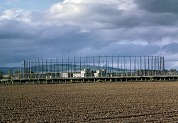 |
|
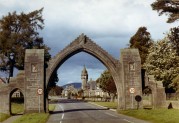 |
 |
|
 |
Background
A Royal Air Force base located in Angus, Scotland, RAF Edzell was situated four miles from the village of Edzell by road, but only one mile directly east, over the North Esk River. The base was active for over fifty years, first as an aircraft maintenance facility during World War II, then in 1960, it was leased to the United States Navy to house a Naval Security Group Activity (NSGA) during the Cold War.
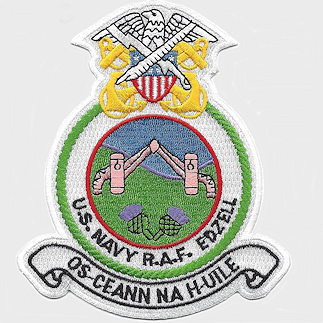 |
|

|
|
|||
| RAF Edzell patch. |
Sign at RAF Edzell main gate (1970) |
 |
|
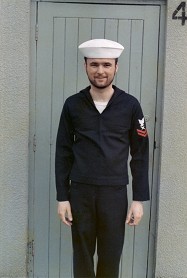 |
| RAF Edzell main gate. | CTR2 Dan Flanagan (1972) |
RAF Edzell was home to the US Naval Security Group Oceanographic Monitoring Station which monitored the North Sea and Britain coast line and the European continent listening for radio transmissions from the Soviet Union and its allies. RAF Edzell was part of a network of sixteen high frequency direction finder (HFDF) facilities located around the world that monitored the electromagnetic spectrum from 2 to 32 MegaHertz.
The base was situated on 440 acres with a lake (Loch Wee) and two 5000 foot runways. The land on the northwest end of the base contained the housing area, the enlisted barracks, the officer and enlisted men's (EM) club, mess hall, medical office, PX (store), post office, and three hangers containing technical shops, and administrative buildings. To the southeast was a World War II airfield, athletic fields, and the communications building which was located in the center of the airfield. The communications building had two levels below ground that housed a computer and communications center and was surrounded by a Wullenweber antenna array which was called the “elephant cage.”
With advancing intelligence gathering technology and the supposed end of the Cold War, the base was decommissioned in 1996 and closed in 1997. The base property was sold off to commercial interests and its stock of 150 houses was sold in 1999 to become an independent village called Edzell Woods.
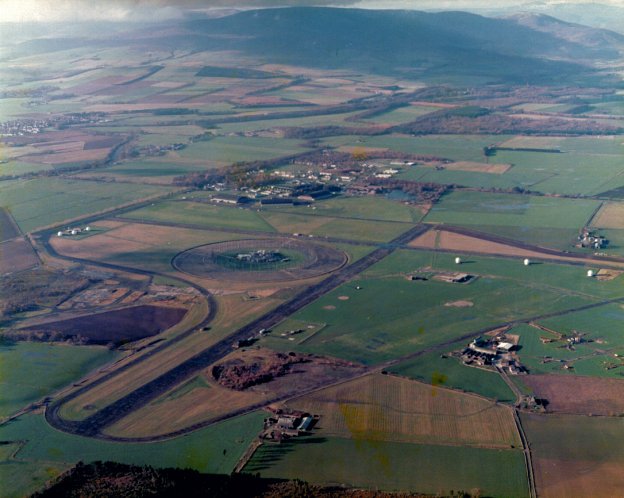 |
|

|
| Aerial view of RAF Edzell looking northwest. You can see the village of Edzell in the upper left corner and the wullenweber antenna array adjacent to the two runways in the center of the image. | Aerial
view of RAF Edzell looking southeast. The enlisted barracks
are
in the center of the photo and the base housing area, now Edzell Woods,
is in the lower
left of the photo. |
My Tour of Duty at RAF Edzell
After I completed Navy boot camp in Great Lakes, Illinois graduating with the rank of Seaman, and completed Class ‘A’ communications school at Corry Field in Pensacola, Florida, I served my first tour of duty at RAF Edzell. At the time (1970), Edzell was one of the Navy’s choice duty stations. Those graduating from ‘A’ school at the top of their class were given the opportunity to choose their first duty station. In my class there were two of us competing for the top spot. We finished only a few one hundreds of a percentage point apart and were both given our choice of duty station. We both chose RAF Edzell. I did not learn of this until sometime later, upon our graduation from 'A' school, the Commanding Officer sent a hand written letter to my parents informing them that I was named an honor student of my class.
 |
|
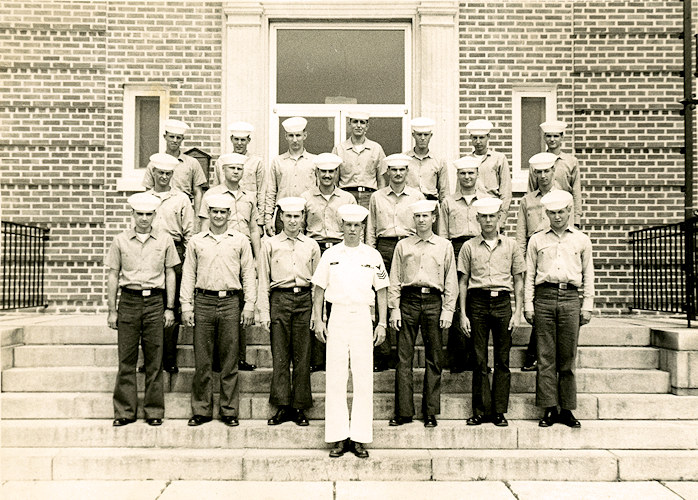 |
| Letter from the Commanding Officer sent to my parents upon my graduation from Communication 'A' School. | Graduating Class CT 'A' School, Pensacola, Florida (May 1970). That's me in the second row, second from the right side, |
RAF Edzell was located in northeastern Scotland midway between the larger cities of Aberdeen and Dundee. The towns of Brechin and Montrose were to the south and east of the base. Montrose, located on the North Sea coast, was the closest large city.
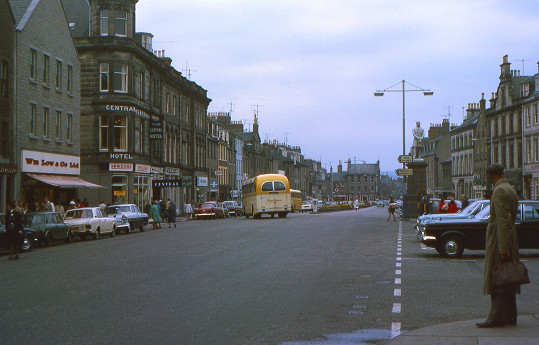 |
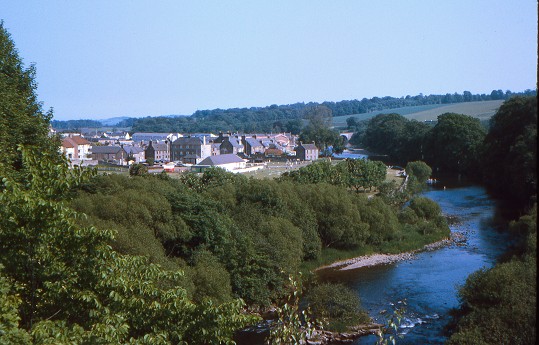 |
|
| High Street on the south side of Montrose. | Outskirts of Brechin. |
During the cold war, Navy and Marine Corps personnel stationed at RAF Edzell monitored the HF radio frequency spectrum looking for clandestine communications from Soviet land based stations, the Soviet Navy and Soviet merchant fleet. There were a few occasions when we listened for satellite telemetry signals just prior to satellite re-entry into the atmosphere. The communications facility was manned 24 hours a day, 7 days a week with rotating watches. There were four watch sections that rotated through a daily schedule. The eve-watch (4 pm to 11 pm), the mid-watch (11 pm to 7 am) and the day-watch (7 am to 4 pm). After completing a round of eve, mid, and day watches one had 80 hours off duty before repeating the cycle.
I arrived at Edzell in late May 1970. My military flight (on a Boeing 707) departed McGuire Air Force Base in New Jersey bound for Germany. There were a number of Navy personnel bound for Europe on this flight. From Germany we flew to Preswick International Airport near the city of Ayr on the southwest coast of Scotland. A taxi took us from the airport to the train station where we boarded a train to Montrose located about 115 miles to the northeast of Ayr. In Montrose, a taxi took us to RAF Edzell located about 12 miles northeast of Montrose. My tour of duty at Edzell was to last 18 months but was later extended to 25 months.
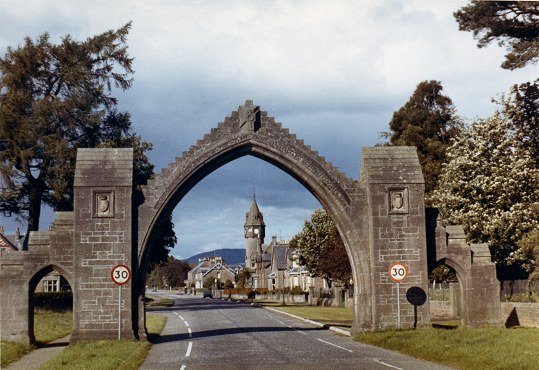 |
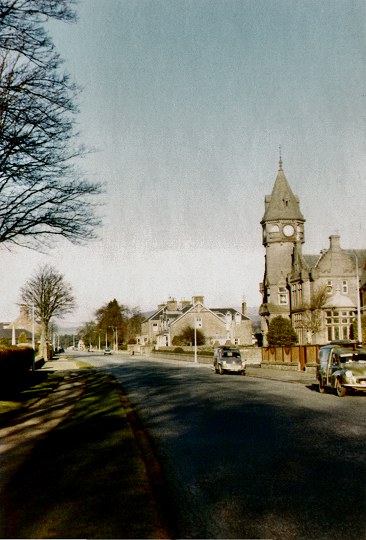 |
|
| 1970: The Edzell Arch coming into town on the east side. | 1970: Edzell village, the west end of town. |
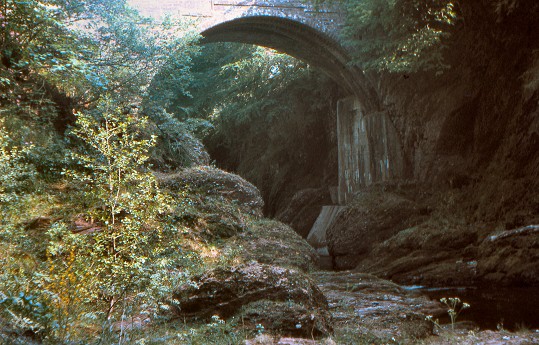
|
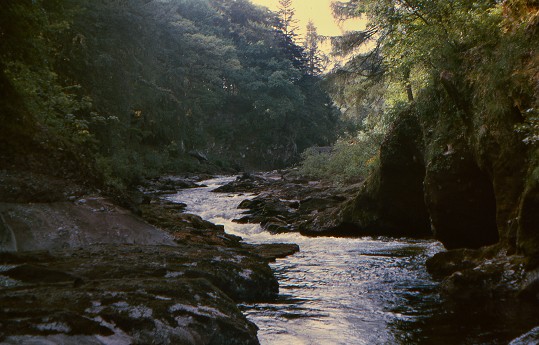 |
|
| 1970: The bridge over the North Esk River. The road on the bridge went into Edzell village. | 1970: The North Esk River. I rode my bike here many times during my first 6 months at Edzell. |
My first six weeks at RAF Edzell were spent completing orientation and training while my security clearance was processed. Orientation consisted of working in the various administrative divisions on base with jobs that ran the gamut from working as a go'fer in the personnel office, to cleaning floors and heads (i.e. restrooms), to maintaining the building's coffee mess. New arrivals were required to attend briefings given by base officers, including the base doctor, personnel officer, and legal officer. Those who had security clearances had to follow a strict set of rules to keep their clearance. When my security clearance arrived in early July, I began my on-the-job training. I was assigned to the high frequency direction finding (HFDF) division, 35 Division, watch section four.
 |
||
| Part of incoming orientation was an interview with the legal clerk. Many of the single men at RAF Edzell wound up taking Scottish brides. The clerk told us that over a third of the single enlisted men got married while at Edzell. During the first year or so I was there one could marry a British national and keep his clearance. This rule was later changed and resulted in loss of clearance. For the guys who did get married, the sign on the legal clerk's desk said it all. |
My first job as a Seaman Communication Technician (CTSN) was to man the four tape recorders that ran 24/7, recording signals received from a large bank of Collins R-390 receivers. My job was to change the reels of magnetic tape which had to be changed every 15 minutes, then stored for 24 hours, and degaussed before being reused the next day. There were two tape machines side by side. When one machine ran out of tape, the second one immediately started and ran while the other machine's tape was changed. Two men manned the tape machines and periodically changed the monitoring frequencies of the bank of R-390 receivers that were located in the same room.
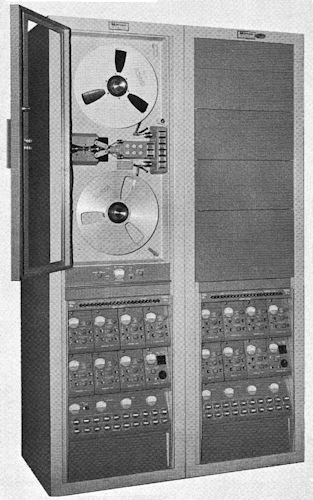 |
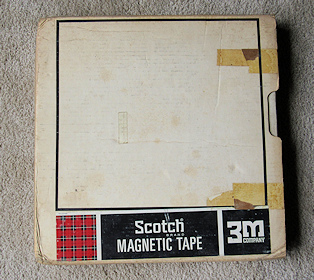 |
 |
||
| Magnetic tape machine. Tape reels had to be changed every 15 minutes. Units used at Edzell had two tape transports side by side. | A 14 inch reel of one inch magnetic tape used in the tape machines. The tape lasted 15 minutes before it had to be changed. | Back room with tape recorders and racks of R-390 receivers opposite the tape machines. |
A few months later, after some new personnel arrived, I moved from this job to manning a radio receiver in the adjacent room. My job was to monitor morse traffic frequencies for activity and pass the frequency and call sign of stations heard to the local HFDF console operator located across the room. During this period I was promoted from Seaman (E3) to Petty Officer third class (E4).
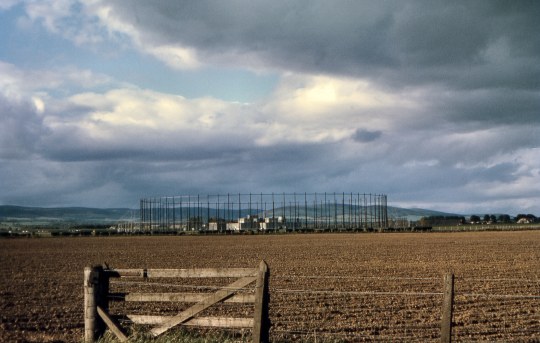
|
 |
|
| 1970: The operations building surrounded by the Wullenweber antenna array. This is where I worked while on duty. The photo was taken from the road leading to the main gate. | The operations building was surrounded by a Wullenweber antenna array called the Elephant Cage. |
 |
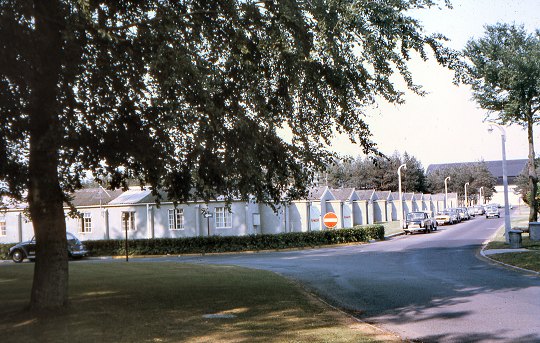
|
|
| 1970:
Photo taken from the road running past the main gate. The
base
can be seen in the distance behind the plowed field. |
1970: The enlisted men's barracks. I lived in the last building on the far end on the road. |
 |
||
| After several months of living in the transient barracks, my first room mate was Tommy Thomas. |
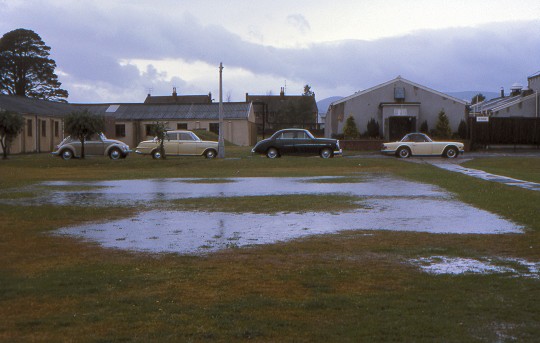 |
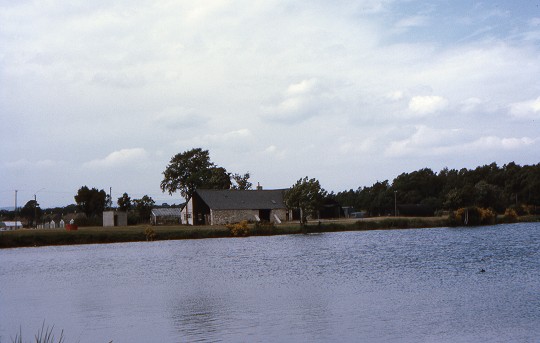 |
|
| View of the EM Club (left) and Chow Hall (right) as seen from the enlisted barracks. | Loch Wee, the lake located on the base. |
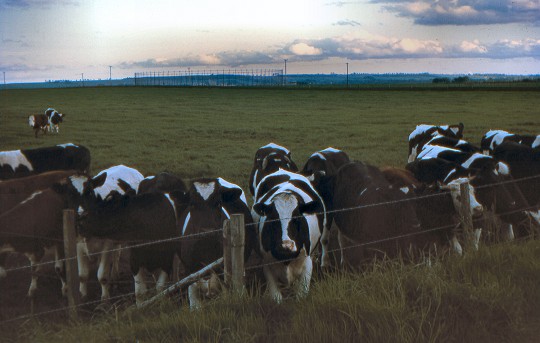 |
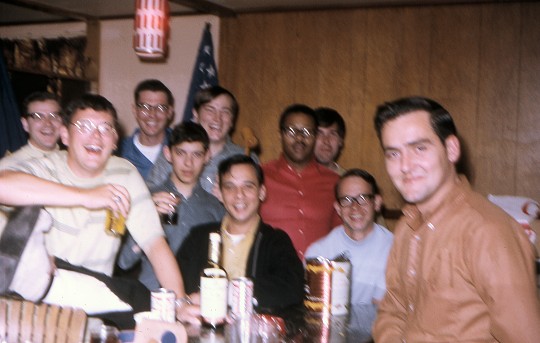 |
|
| Some local residents near the base - genuine Angus beef. | 1970:
My
watch section, 35 Division - Section 4. The guy in the
center,
with the black jacket behind the whiskey bottle is Gene - GM5AQM. |
Working
the main DF
console was an ideal job for an amateur radio operator. I had
a
state-of-the-art Racal receiver at my console that could be
connected to an array of antennas. During the mid-watch when
things
were slow, I would listen to the amateur bands and do some short wave
listening. During the mid-watch, when radio propagation
conditions were good, I could hear stations in the
U.S.
AM broadcast band (540 to 1600 kc).
In the room with me was several work stations with R390
receivers, typewriters and headphones. These work stations were
manned by marines who copied real-time Soviet morse traffic.
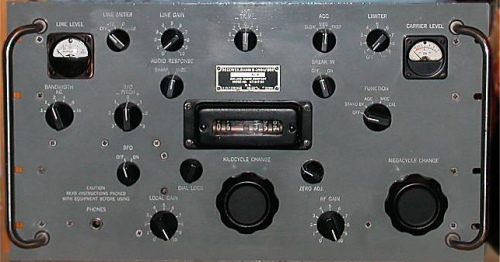 |
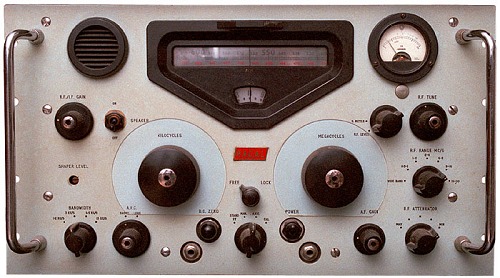 |
|
| Collins R-390 receiver, the work horse tool of the CT. | Racal RA17 receiver I used at the main DF console. |
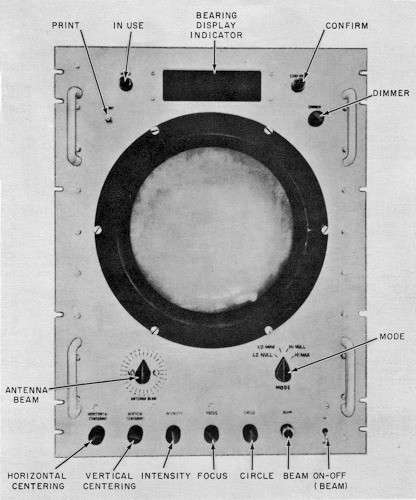 |
 |
|
| Channel Watch Position O-Scope -AN/FRD-10(V) | Channel Watch Position AN/FRD-10(V). This
is where the first bearing was taken. It was then passed to the
Main DF console where I sat to verify it and send it out to the global
network. |
Amateur Radio From RAF Edzell
Shortly after arriving at Edzell,
I located the amateur radio club and it’s club station which was
conveniently located about a 3 minute walk from the enlisted
barracks.
In July 1970 I got a ride from one of my buddies and went to the post
office in Montrose and filed an application for an amateur radio
reciprocal license. The license arrived about a month
later assigning the call GM5ASI to me. U.K. reciprocal
licenses were restricted to a maximum of 150 watts on
CW and 400 watts peak envelope power (PEP) on phone (voice).
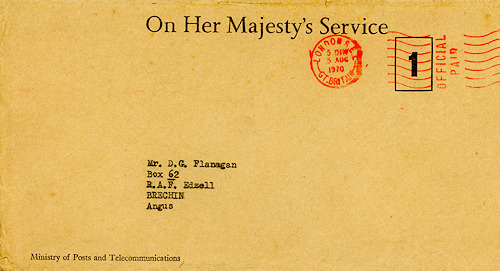 |
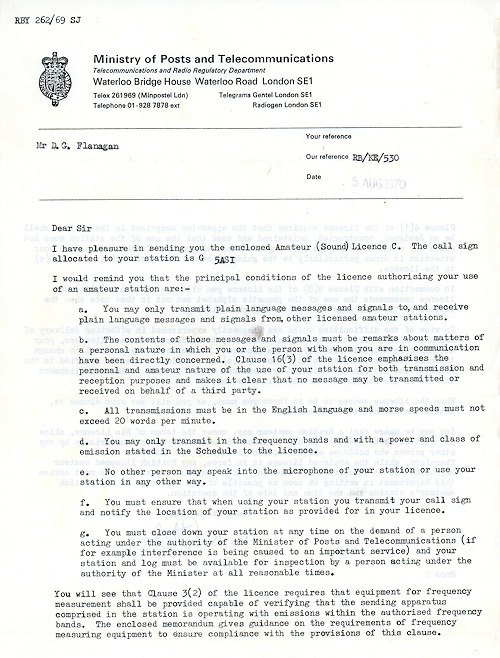 |
|
| GM5ASI Reciprocal License. |
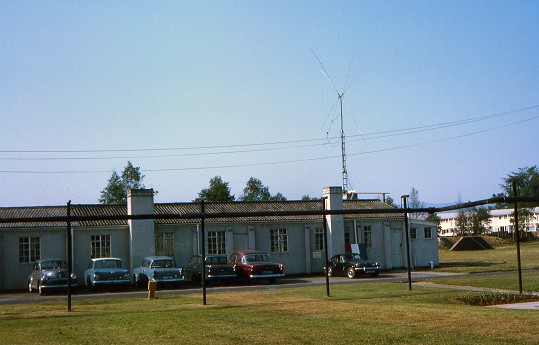 |
 |
|
| The ham shack was located between the enlisted barracks and the housing area. | Ham shack was equipped with a Swan 350 transceiver and Drake 2B receiver. |
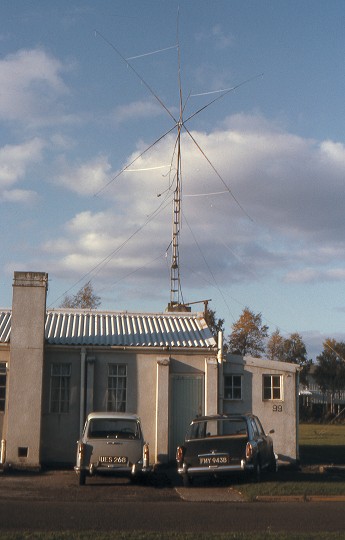 |
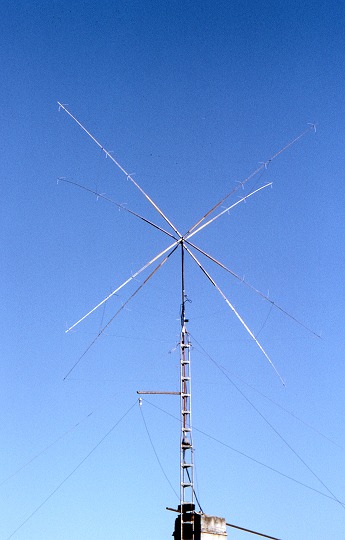 |
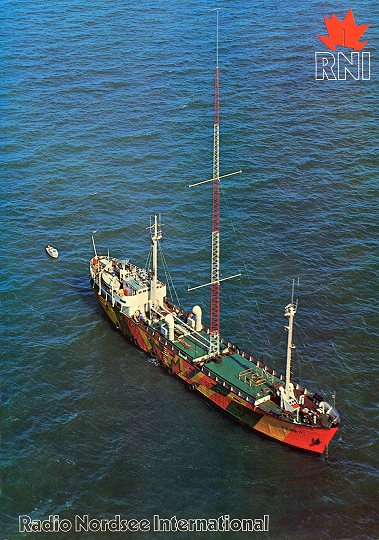 |
||
| Ham shack with tower, GEM quad and 40M inverted vee. | The GEM quad covered the 20M, 15M and 10M amateur bands. Below it is the 40M inverted vee. | Radio
North Sea International - I listened to popular music
broadcast by
this pirate station in the North Sea. In 2009 a movie was
made about
it bringing back memories which prompted me
to dig out
the souvenier book I had. |
The club station was equipped with a Swan 350 transceiver and a 20/15/10 meter quad on a 30 foot tower. A 40 meter inverted vee was hung from the tower. The GEM quad (Canadian made) was a boomless quad that gave me my first exposure to the quad antenna. I was quickly impressed with it’s performance. I made my first ham radio contacts in mid August 1970, began working DX (distant stations), and looked for ham friends back home in Baltimore when I was on the air.
In early 1971, a Drake 2B receiver was added to the station by another club member, Steve - GM5AXO (WA4UAZ - now K4EU). The Swan 350 receiver was not very selective making CW operation on a crowded band difficult. During the spring of 1971 we erected a full size 80 meter vertical made from spare sections of light duty tower. That spring and summer I buried 60 quarter wave radials under this antenna to improve it’s DX performance.
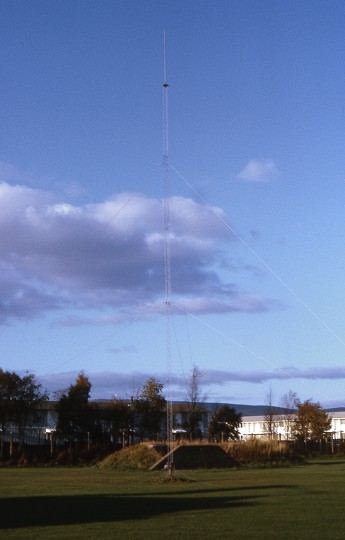 |
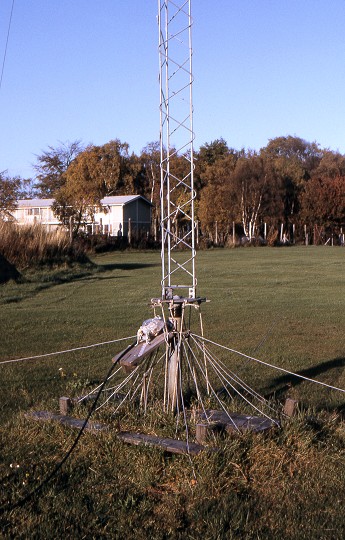 |
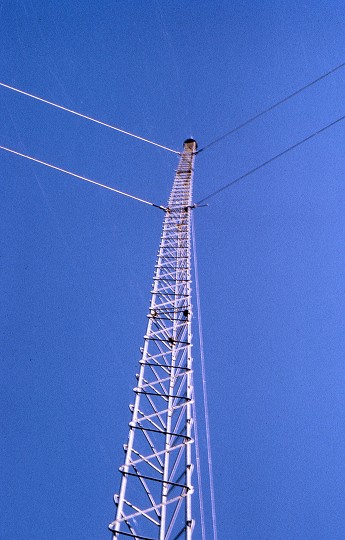 |
||
| Full size
80M vertical erected in 1971. I added 60 quarter wave radials
that summer. |
The base of the 80M vertical with matching coil and buried radials. | The 80M vertical was made from the same TV tower used to hold the quad. |
In
1970 I had been licensed for a little over two years.
Operating from Scotland was a new experience for me. My
station back home was a simple one operating only on CW. In
Scotland I was able to work single sideband (SSB) and acquired some
on-the-job training in handling pileups.
When the 15 and 20 meter bands were open, a CQ would
generate a pileup of stations calling. I spent many nights
working pileups of U.S. stations on 20 meters until the band closed
shortly after local sunrise.
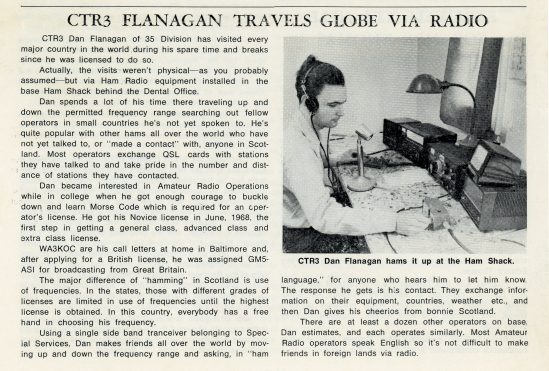 |
|
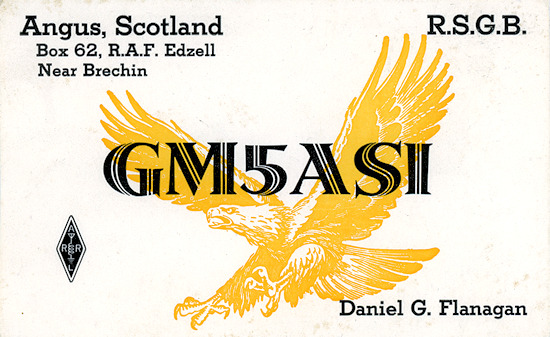 |
| A
friend of mine was a reporter for the base journal called the Tartan
Log. He had an interest in ham radio and wrote an article for
the journal featuring yours truly which appeared in the July 19, 1971
issue. Click
here for a larger image. |
My Scotland QSL card. |
Two of my ham friends back home kept a nightly schedule on 80 meter CW. John, W3FHT (now SK) lived about two miles from my home outside of east Baltimore, and Merlin, W3HSD (now SK), lived in Manchester, MD. They both ran low power rigs (90 watts DC input) and simple antennas. John ran an Eico 720 (the same transmitter I had at home) into an inverted vee hung from the roof of this town home and Merlin ran a DX-60 into a dipole. Merlin also had a base loaded 80M vertical with 120 radials which always provided the strongest signal in Scotland. After we erected the 80 meter vertical I was able to make contacts with John and Merlin regularly in the wee hours of the morning (4 am Scotland time, 10 pm east coast time). There were nights when their signals approached S9 at my sunrise. In 1971 and 1972 this was a noteworthy accomplishment since most amateurs did not consider 80 meters to be a reliable DX band back then. I still have the QSLs from our best 3-way 80M QSO on April 8, 1971.
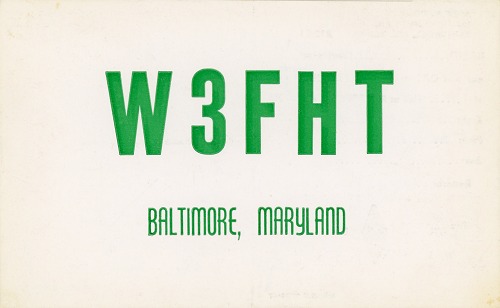 |
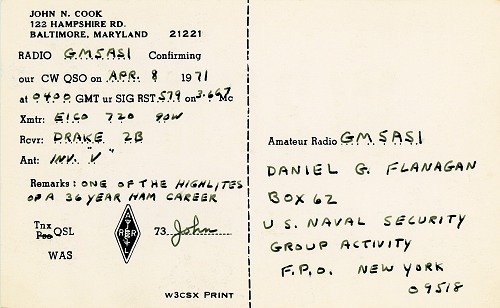 |
|
| John's
QSL for our 80M QSO, a 3-way with Merlin with good signals. |
||
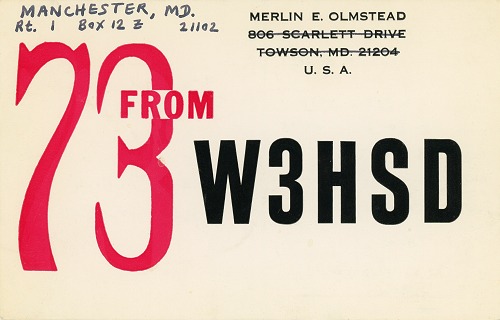 |
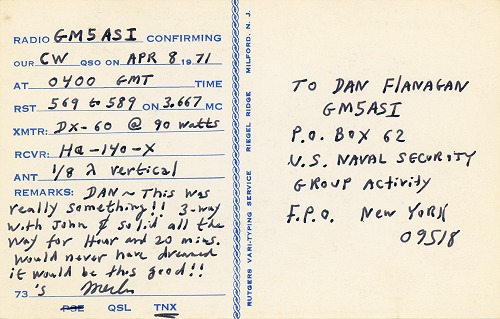 |
|
| Merlin's
QSL for the same 3-way QSO which lasted 80 minutes. |
I also made regular contacts on 20 meters with friends back home. A group of Baltimore area hams met on 14.260 Mc plus or minus QRM several times a week. Communication with home was very limited on base. One could make long distance telephone calls only with a pre-arranged appointment and at great expense. To get around this limitation, I worked out a system with one of my friends in the 20 meter group to get messages home to my parents. Since there was no third party agreement with the UK at the time, we had a “code word” that alerted my friend back home that I wanted to pass some information to my parents back home. When he heard me say the code word, he would call my home and connect his receiver to his phone patch and I would pass my message as if I was having a normal conversation (QSO) with him. This secret arrangement saved me many long distance telephone calls.
My Travels In Scotland
When my off time fell on the weekend, I visted the Enlisted Men's (EM) club on Friday and Saturday nights. The EM club, was the hangout on base for the single enlisted guy. On Friday and Saturday evenings a bus load of girls from the city of Dundee arrived on base to come to the club. They were known as the Dundee Runners. When I first arrived at Edzell they were allowed to come into the club unescorted. After about a year the base clamped down and required that they be signed in and escorted on and off the base. The EM club provided a local band for dancies, a bar, and food for general entertainment. The most popular of the bands was one by the name of Jynx that played there almost every weekend. My normal routine on nights that I went to the EM club would be to drive to Brechin to a pub called Jolly's. Jolly's was in Brechin and was a favorite hangout of the enlisted men. It was also a family oriented pub, like most of the pubs in Scotland. When Jolly's closed at 10 PM I would head back to the base to the EM club until it closed at 2 AM. Needless to say I met some interesting people at Jolly's and had many interesting experiences at the EM club.
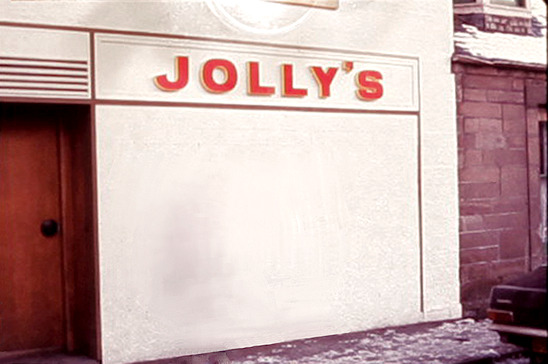 |
|
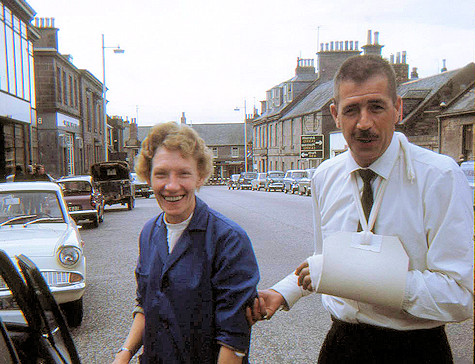 |
|
| Jolly's pub located in Brechin. | Jolly's proprietor Archie and bar maid Flora. (photo circa 1968) |
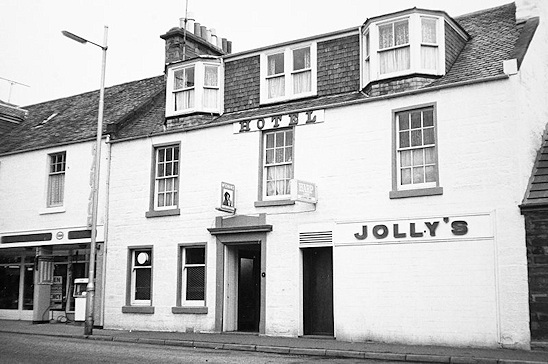 |
|
 |
| Jolly's pub and hotel, 12 Clerk St, Brechin. (photo circa 1975) | 12 Clerk St, Brechin (photo circa 2025) |
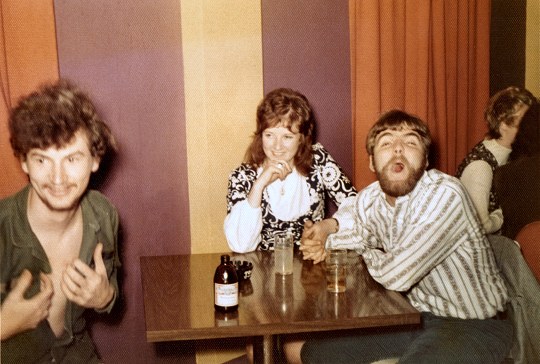 |
|
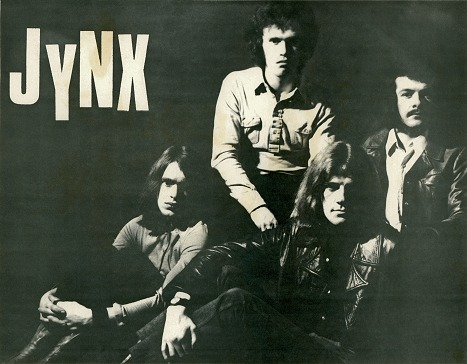 |
| Partying at the EM Club. The enlisted guys lived for the weekends so they could party at the EM club with the Dundee Runners. | Jynx played at the EM club just about every weekend. They handed out this black and white photo at their gigs to promote the band. |
When
I was not on the air or partying at the EM club, I traveled around the
Scottish countryside. RAF
Edzell was out in the middle of cow and sheep pastures. At
first I used
a bicycle that I bought at the PX to get around, taking trips to the
nearby villages of Edzell and Fettercairn. The local roads
were lightly
traveled. The roads where narrow, single lane, with no shoulder, lined
with stone walls in some areas and just wide enough for two small cars
to pass.
If a lori (truck) came along you had to get off the road. As
my
exploring branched out, I rode my bicycle with a buddy to a
place called Cairn ‘O Mount. We passed through Fettercain on
the
way
there. The ride was challenging, mostly up hill, but
well
worth the effort once we reached the top. The trip back went
quickly since it was down hill just about the whole way. The
round
trip was approximately 20 miles. When not cycling, I rode the
bus. Two buses made stops at the base each
day. I rode the bus into Edzell, Brechin, and
Montrose to
explore
the towns. The local people were very friendly and I
discovered some very reasonably priced restaurants that served local
Angus beef that I visited regularly when I got tired of eating the chow
hall food.
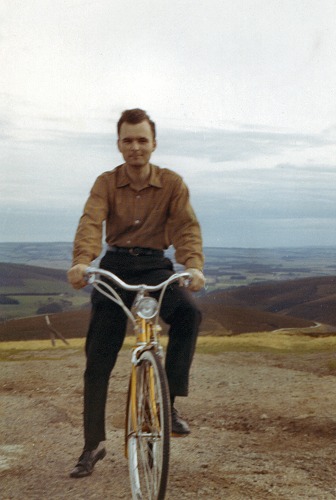
|
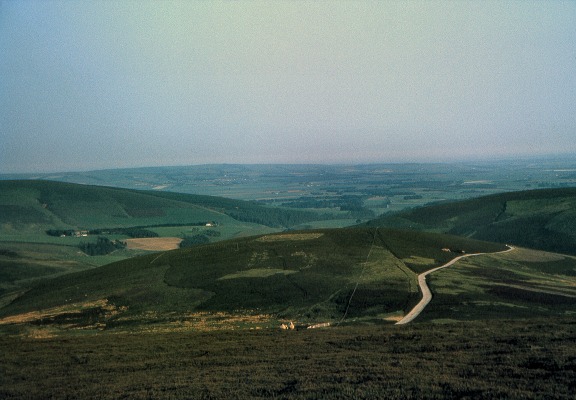 |
|
| 1970: Biking to the top of Cairn'O'Mount. | Cairn'O'Mount was 10 miles North of RAF Edzell. |
| Some of the scenery around RAF Edzell | ||
 |
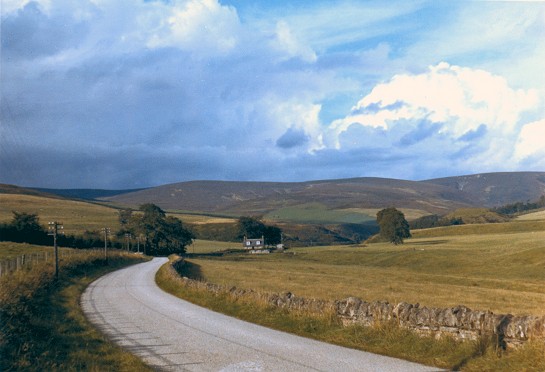 |
|
| Edzell Castle | Typical road around RAF Edzell. | |
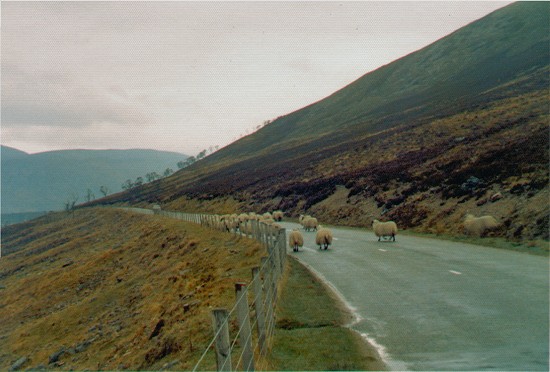 |
 |
|
| A Scottish traffic jam. | Sunset around RAF Edzell. |
One of my buddies, Earl, was a car enthusiast. He acquired a 1940s era car and I spend some of my off time helping him fix it up. We began traveling the roads together in his car. I did not have a drivers license but Earl would let me drive the car on some of the dirt roads we traveled. After riding a bicycle, the bus, and relying on my friends for transportation during my first six months at Edzell, I decided to learn to drive. In late 1970, I obtained a learners permit and purchased a 1963 Austin A40 from a local bloke for 90 pound and began learning to drive with the help of my buddy Earl. A short time later, Earl met a local girl and was not available much so I enrolled in a driving school and got my British drivers license in early 1971.
Learning to drive in Scotland was quite different from learning to drive in the states. Aside from driving on the left side of the road, the requirements to obtain a license were very demanding by U.S. standards. One not only had to perform the required maneuvers correctly, they had to be performed a specific way to pass the test. (My British drivers license was only good for 30 days once I returned home.)
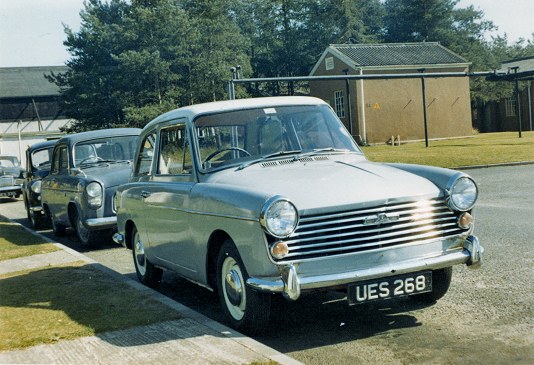 |
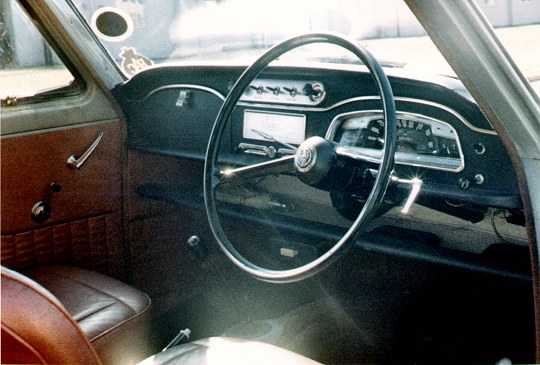 |
|
| My first car was a 1963 Austin A40. | Interior of the Austin A40 - barebones. |
 |
|
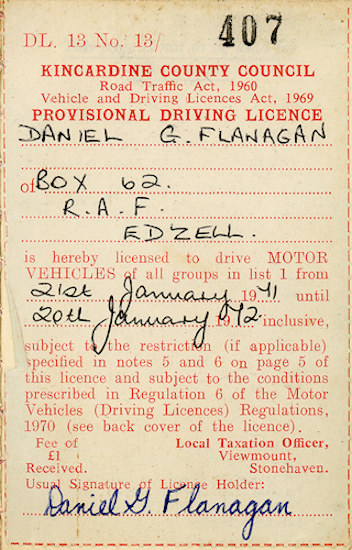 |
|
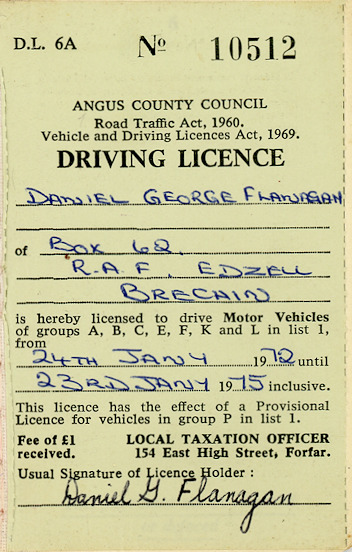 |
| My second car was a 1960s Singer Gazelle. | Provisional drivers license. | Full drivers license. |
My Austin A40 had a manual non-synchronous transmission which meant that when you needed to down-shift you had to double clutch in order to synchronize the gears before they could be engaged. At first I drove the driving school’s car which was much newer and quieter than my car and had a synchronous manual transmission. At first, this caused me some difficultly since I could not hear the engine well enough to know when to release the clutch. After mastering the basics on the school car, I drove my car during lessons. After a few months of practicing all the required maneuvers, I was ready to take the exam.
The exam consisted of driving in city traffic and on local roads following the directions of the examiner. The test included stopping the car on a hill and then proceeding forward without drifting backward, backing around a street corner staying no more than three feet from the curb, turning and maneuvering in traffic, making an emergency stop without losing control of the car, and answering oral questions at the end. During my driving test I was very nervous and did not follow the examiner’s instructions precisely and failed the test. I went back a few weeks later and passed the test with no problem.
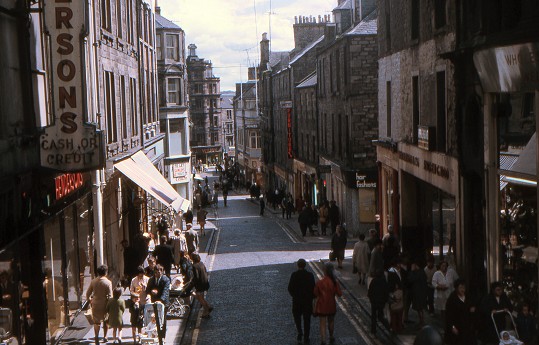 |
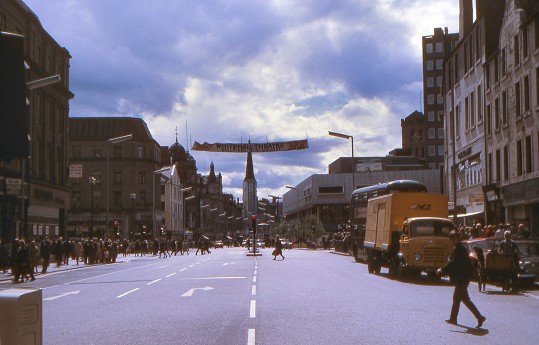 |
|
| Dundee - the closest "large" city to Edzell. | Dundee - looking down Commercial Street. |
With
my car and newly acquired
drivers license I began
exploring the countryside farther from Edzell. During my off
duty time I
would travel to the towns in the area, slowly branching out farther
from Edzell. One of my other hobbies was
photography. I carried my
Argus C-3 camera with me on these trips and took pictures of
the
countryside. I
drove to Aberdeen, Dundee, Montrose, Brechin, Glasgow, Inverness, St
Andrews, Forfar, Arbroath, Fettercairn, Stonehaven, and many other
towns whose names I can not remember. My trips to Aberdeen were
usually
to an electronics/TV repair shop to purchase tubes (called
valves by UK natives) for the Swan
350 tranceiver The proprietor of the store was a ham (I don't remember his GM3 callsign). During
this
period I met and
dated some local girls and spent evenings in the pubs of Brechin and
Montrose. The Scottish pubs were social gathering places for
family and
friends. The local area pubs all closed at 10 PM.
The favorite
gathering place of the single enlisted Navy guys was a pub
called
Jolly’s in Brechin.
 |
|
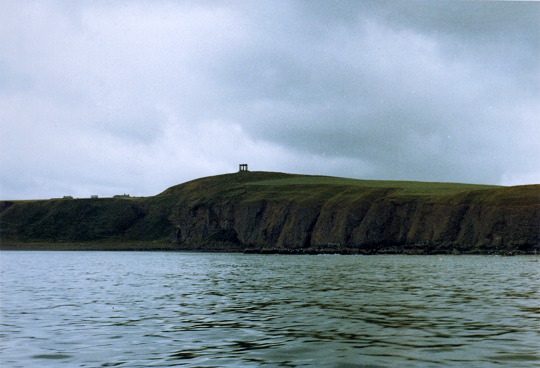 |
| 1971:
Stonehaven fishing trip - Leaving the harbor to do some fishing in the
North Sea. |
1971: Off the coast of Stonehaven in the North Sea. The water looks calm but got pretty rough when the wind picked up a few miles out. |
During
the summer of 1971 a few of the guys in my watch section
arranged
a fishing trip out of Stonehaven. We leased a small boat and
went out into the North Sea to do some serious fishing, hoping to catch
some big ones. Everything was fine until we got a few miles
off
the coast where the wind picked up and the water got rough.
About 2 hours into the trip, one by one, most of us got sea
sick.
Once the first one got sick there was a chain reaction and we
spent
most of the 8 hour trip leaning over the side of the boat feeding the
fish. The old guy piloting the boat just smiled at us and
must
have been thinking "These yanks are in the Navy?" A
couple
of the guys were able to fish but they did not catch much.
I had my camera with me but was only able to take the
pictures
above early in the trip. I was never so glad to get my feet
back
on dry
land. At the time, I did not know that I would get sea sick
on
this trip. As a kid I had been out in small boats on the
Chesapeake Bay in Maryland several times and never got sick.
The
waves in the North Sea were much larger than the ones in the
Chesapeake Bay.
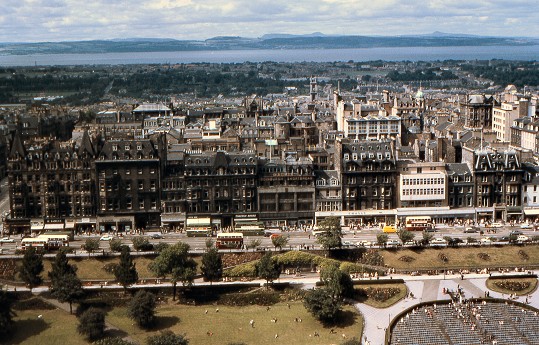 |
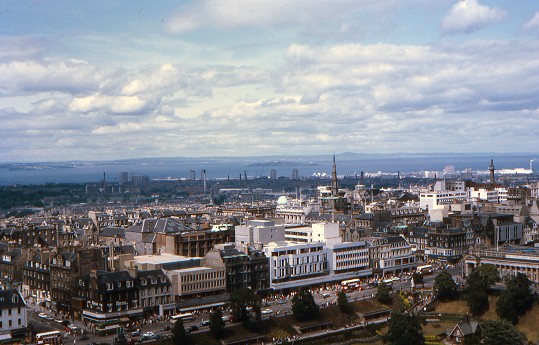 |
|
| Edinburgh was the cleanest city I ever saw. I visited Edinburgh several times. | Edinburgh as seen from Edinburgh Castle. |
In
late October of 1971 I took a week long trip to Paris and
explored the city on foot taking lots of photos along the
way. Later
that year I took a road tour of the highlands of Scotland, visiting
Loch Ness and scanning the lake for the famous Loch Ness
monster. I
don’t remember how many miles I put on the Austin A40, it was a lot.
During the year I had it on the road I had some minor
problems
with the car. The car had a lot of body filler on it,
espically
around the headlights where it had rusted out. While driving
back
to the base one night, I hit a pot hole in the road which caused the
left front headlight to fall out and dangle from the front of the car.
I had it repaired at a body shop in Montrose at a reasonable price.
Every now and then while cruising the Scotish roadways the
engine
would stall out, nearly stranding me a few times, but luckily I was
always able to get the engine started again. After this happened a few
times, I found that the gas line going to the gas tank did not have a
tight fit and it would pull air instead of gas when this
happened. I was able to easily fix this with a small hose clamp.
In
late 1971
it developed major mechanical problems. I junked it and
acquired a
Singer
Gazelle (not a sewing machine) which was a few years
newer. This car was larger
and more
comfortable than the Austin for road tours and had a five speed
synchronous manual transmission with overdrive.
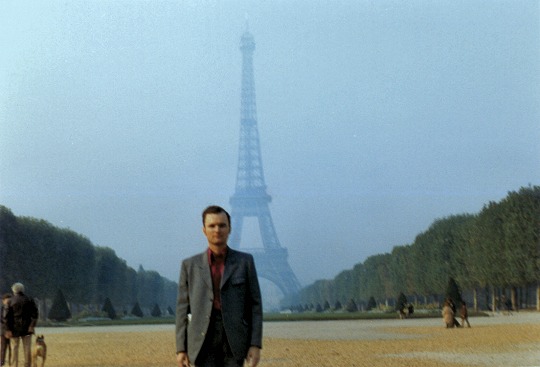 |
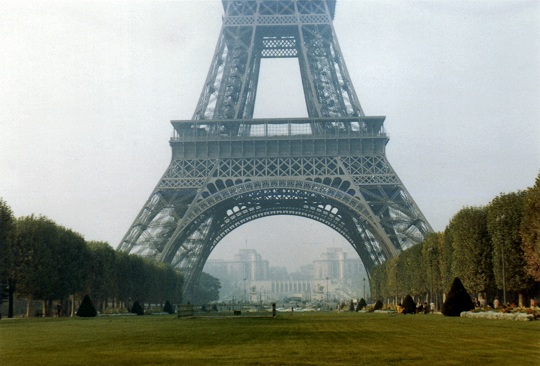 |
|
| Paris October 1971: Me standing in the Garden of Champ de Mars with the Eiffel Tower in the background. | Paris October 1971: The Effiel Tower with the Palais de Chaillot in the background. |
In March 1972 I drove to London on two separate occasions to visit the family of a girlfriend. I stayed with Ronnie, the older brother who lived in Islington, London. Ronnie, who worked as a steeplejack, showed me the buildings in London he had worked on and showed me parts of London the average tourist would never see. I had an interesting experience in a Welsh pub one evening with Ronnie. When I entered the pub, the place went silent and everyone in the place was staring at me. After Ronnie announced that I was his friend, the place returned to normal. Later that evening, I was told that everyone thought I was an officer from Scotland Yard.
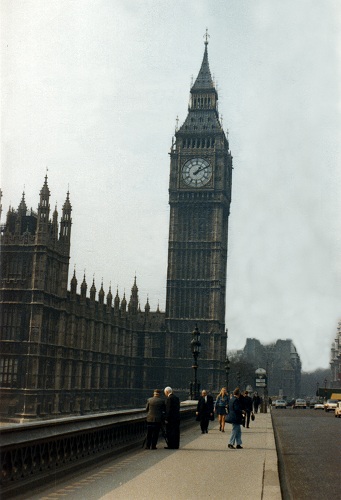 |
 |
 |
||
| London's House of Parliment and Big Ben. | London guard - 10 Downing Street. | London March 1972: Feeding the pigeons at Trafalgar Square. |
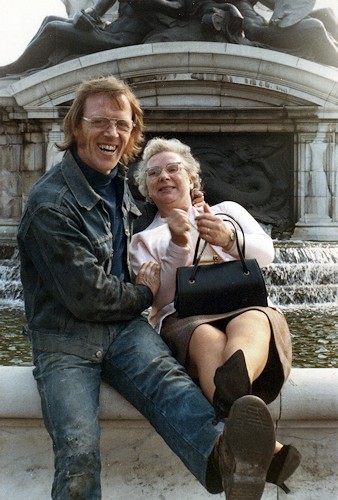 |
|
| Ronnie and his Mum Margaret, Trafalgar Square |
Just before my second trip to London, I received orders to Fort Meade in Maryland not far from home. At the time I thought that this was too good to be true, that is, being in the Navy for four years and never being stationed aboard a ship. As it turned out, it was too good to be true. I began my second drive to London at night so I would arrive during the day. Several hours into the trip fog set in and got so thick I could not see the road. I was forced to pull off the road and wait for daybreak before I could get back on the road. Upon my return from London, I was notified that my orders had been cancelled. About a week later I was notified that I was in a “select group” of communication technicians whose rating would be changed.
The CT rating was a critical rating when I completed ‘A’ school in 1970, but in the following two years the Navy had to cut back it's CT billets. There were too many active duty CTs, the Navy had to downsize the rating, and I was in the “select group” to be taken off the CT books so to speak. Everyone affected was given the opportunity to re-enlist to escape the situation. Since I had only 13 months left on my enlistment and knew that I was not going to make the Navy a career, I chose not to re-enlist and stick it out until my active duty tour was over. Those of us in the “select group” got to choose from a list of ratings to select a preferred rating. We were instructed to choose three ratings in order of preference. The choices were limited and a lot of the ratings were non-technical. When all was said and done, I was converted to a yeoman (my last choice) in June 1972 just prior to my departure from RAF Edzell. I received orders to report aboard the USS Grand Canyon (AR-28) in Newport, RI. During my last days at Edzell, the affected group of sailors, about a dozen of us, met with the base Commander for a pep talk before we left to go back to the States on June 23, 1972.
 |
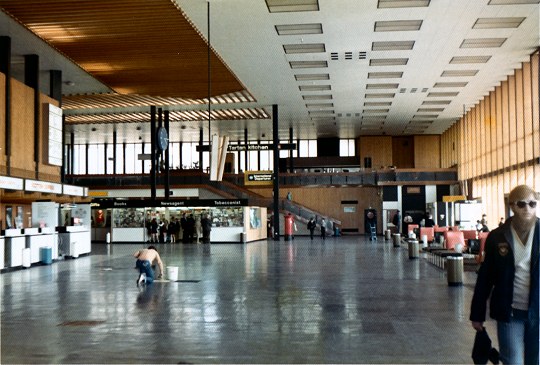 |
|
| Ayr International Airport. | Ayr International Airport. |
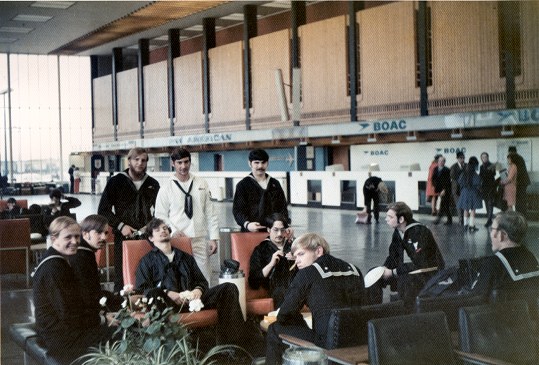 |
 |
|
| June
1972: The Edzell gang leaving for home and our next
duty
stations. We called ourselves the "Shit Can Gang" to
commerate our new rating. |
June 1972: Killing time with a card game in the hotel room the night before leaving for home. |
The night before we departed Scotland, we stayed in a hotel in Ayr. All during my stay in Scotland the people I met were very friendly. My only bad experience occurred on the last night I was there. A group of us spent the evening eating and drinking in the hotel pub. A few local blokes there, who had a little too much to drink, noticed we were Americans, made some idle threats and tried to start a fight. After exchanging some words with them, we stuck together and stood our ground and they left without an incident.
Post Edzell
I returned home to Baltimore and spent 30 days on leave. In late July 1972, I reported aboard the USS Grand Canyon (AR-28) and served the remaining 13 months of my military duty in Boston, MA, Brooklyn, NY, Newport, RI and Guantanamo Bay Cuba. As a yeoman who worked in the personnel office on-board ship, I was responsible for processing re-enlistments and separations, among other things. So it was with great pleausre that I processed myself out of the Navy in August 1973.
|
|
|
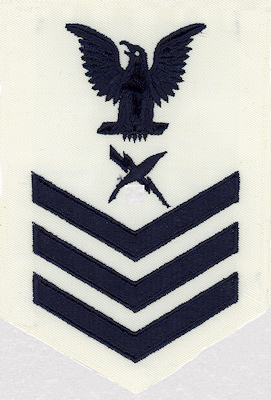 |